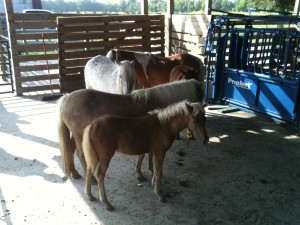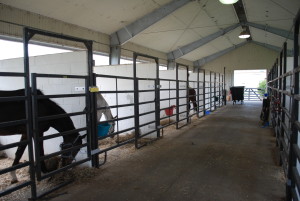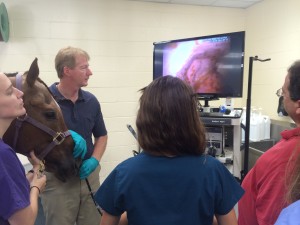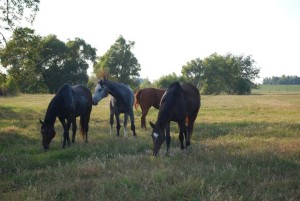Original Publish Date December 2015
Dr. Frank Andrews, DVM, is the Director of the LSU Equine Health Studies Program, part of the Veterinary School at Louisiana State University in Baton Rouge. The program is funded partially by a tax supplement from slot machine revenues at the four Louisiana racetracks. This “statutory dedication” (revenue dedicated by state law or by the state constitution) benefits the health and welfare of horses not only in racing but also in any sport or backyard in the state.
Private donations and grants are an essential supplement to state support. Friends of the Equine Health Studies Program have contributed to leading-edge research, professorships, continuing education for the horse-loving public, and modernization of the hospital. Corporations like Boehringer Ingelheim Vetmedica, Zinpro, Purina, SeaBuck Equine LLC, Triple Crown Feeds, and SmartPak contribute, as well as organizations (in the form of competitive grants) such as the Morris Animal Foundation, the National Institutes of Health, the Grayson Jockey Club Research Foundation, and the Louisiana Governor’s Biotechnology Initiative Grants Program. One example of significant generosity is the new $5.3 million Isolation Unit, which was partially funded by the John Franks Foundation in Shreveport, LA. “John Franks was a famous owner of racehorses and a distinguished LSU alumnus,” says Dr. Andrews. “He had a thousand horses racing and training in the 1980s. In this new unit, we can separate horses with strangles, diarrhea, or other infections from our main population of horses.”
Researchers and veterinary students appreciate the donation of horses to the research program. The identity of horses and donors is kept confidential. Dr. Andrews writes (in the LSU EHSP 2014 Equine Research Report): “These horses are valued members of our program and are treated with kindness and dignity.”
Dr. Andrews praises the state-of-the-art Veterinary Hospital facilities available to the Equine Health Studies Program, in particular the MRI, CT, and nuclear scintigraphy units for imaging soft tissue and bone. The dynamic endoscope allows a horse’s upper airway to be viewed and analyzed while the horse is exercising at the farm, racetrack, or on the high-speed treadmill, another high-tech state-of-the-art piece of equipment at the LSU Veterinary Hospital. Digital motion analysis of gait and lameness, equine stem cell research, design of orthopedic implants, laser surgery, molecular biology research, and advanced reproductive techniques all contribute to the cutting-edge reputation of the LSU EHSP. 
Imagine a sophomore in college who loves science and animals and wants to go to veterinary school. What advice would you give that student?
GET EXCELLENT GRADES IN COLLEGE! The first two years of college are critical. If you get a low GPA your first two years of college, you won’t be able to bring it up and it might be “too late” to get into veterinary school! The students who get into vet school, here and nationwide, have an average GPA of 3.7. If you can get a 3.5 to 4.0 your first two years, you set up good study habits and your chances of getting in are greatly increased.
I’ve heard that vet school is harder to get into than medical school.
Well, since there are fewer vet schools than medical schools, it can be just a numbers game. We used to have just 28 vet schools in the nation, but four more have opened up recently in Arizona, California, and the northern part of Tennessee, and Alberta, Canada.
In Europe, a vet school might accept 150 or 200 students, and then make the comment on the first day, “Look to your right and look to your left—one of those people won’t be there at graduation.” They start out with larger classes and weed students out. [Yes, American veterinary schools are hard to get into,] but once a person gets into vet school, we do everything we can to make students successful. Sometimes students will drop out of veterinary school; they applied because they love animals, but then they realize that they do not like the science part and do not like memorizing anatomy structures. But this rarely happens, as over 95% of the students finish with DVMs!
 The LSU School of Veterinary Medicine gets between 700 and 800 applicants each year. About 90 will get in. It is competitive. If you make it to the interview stage, you have a 50/50 shot at getting in. [Dr. Andrews says that strong recommendations, convincing essays, experience with animals, and a great interview all make a difference—but, to get past the initial cut, a student must have “the numbers”–a high GPA and a high score on the Graduate Record Exam.]
The LSU School of Veterinary Medicine gets between 700 and 800 applicants each year. About 90 will get in. It is competitive. If you make it to the interview stage, you have a 50/50 shot at getting in. [Dr. Andrews says that strong recommendations, convincing essays, experience with animals, and a great interview all make a difference—but, to get past the initial cut, a student must have “the numbers”–a high GPA and a high score on the Graduate Record Exam.]
[Since the state of Arkansas doesn’t have a veterinary school,] we have a contract with Arkansas to take 8 or so of their students. The students pay in-state tuition and the state of Arkansas makes up the difference. Students from out-of-state and even from foreign countries like China or England or Mexico make up about 25% to 30% of each entering class. We get a number of applicants from the northeastern states, because the out-of-state tuition at LSU is still lower than tuition at the University of Pennsylvania or Cornell University.
What percentage of LSU veterinary students want to study equines?
Every veterinary student is required to take equine medicine and surgery for four weeks. About half of them express an interest in equine studies, and perhaps 10% of them actually go into equine practice once they graduate. There is a worry out there that there aren’t going to be enough large animal vets. A lot of the horse vets out there are older, and there aren’t enough people coming up to take their places. [Part of the problem is the economics of the profession:] Sometimes rural vets don’t make as much money as the small animal vets, who can stay in their practices and look at four or five patients an hour. If you’re out on the road you can only look at one patient an hour.
That said, I’m impressed with how many good horse vets we have here in Louisiana—from my limited perspective! We have a strong horse culture.
Before I came to LSU I spent 20 years at the University of Tennessee in Knoxville—and when I came to Louisiana I noticed that pretty much everybody you talk to owns a horse, grew up with horses, or had grandparents who raised horses. Western Mississippi, Southern Arkansas, and Eastern Texas have big horse cultures, too.
How are the four years of veterinary school structured?
For the first two-and-a-half years, the students do book learning and anatomy. They dissect legs, for instance, and they are assigned a dog to dissect. Very much like when you donate your body to science, for the education of medical students. We have horses for dissection, too, donated in the same way. The dogs and horses have all been humanely put to sleep.
Then the students learn functional anatomy. We take them out and show them a live horse so that they are able to take what they learned in dissection and apply it. They don’t do any cutting on a live horse, but they are able to palpate and explore where the internal organs touch the body wall and where the nerves run. In February of the third year they start clinic rotations. Each month they rotate. One month they might do equine medicine and surgery, and the next month they might do food animal medicine and surgery. When cases come in, the students examine the patients, take histories from the clients, and learn the procedures and diagnostics.
[Dr. Andrews explains that the LSU School of Veterinary Medicine has a licensed social worker on the staff. She is available to counsel students who are feeling stressed, but she also teaches students how to handle difficult situations with clients. The most difficult situation, of course, is euthanasia.]
We love animals, but we also don’t want them to suffer when they get severe disease. Veterinarians have the ability to make decisions about pets which you don’t have with humans. In the human world, if a patient is suffering you try to minimize the pain. With a dog or cat or horse, you don’t feel quite as helpless in certain situations. We try everything we can, but when there is no hope, we have certain options to ease pain and suffering.
The students are trained by having videotaped interviews with mock clients. We usually work with owners from the outside. They have scripts to memorize—they might play the “emotional person,” for example. Faculty watch through a two-way mirror. We teach the students how to talk with clients and how to take a physical exam. We teach them what questions to ask–a lot of times the way you ask a question is the way you are going to get an answer.
And then there’s a problem that veterinarians face more often, I think, than human doctors do—the issue of how much a treatment is going to cost.
We try not to make the issue of cost the first thing out of our mouth—“How much can you afford?” For instance, we have a standard colic protocol. Most of the colicky horses that come to the LSU clinic are referred from other veterinarians. The local vet may not be able to control the pain, so they talk to their client about taking the horse to LSU or some other surgical facility. If the client says yes, the veterinarian calls us and tells us the horse is coming. [Sometimes the trailer ride fixes the horse!] Once we do the workup and get all the information, we communicate with the client and say your horse may need to have surgery or your horse may be able to be treated medically, and we discuss costs. Medical treatment runs $1,000 to $3,000; average is $2,000 to $3,000. Surgery, plus the aftercare, can run up to $10,000. I think our average is around $5,000 to $7,000 for surgery.
What percentage of horses engaged in rigorous sport can return to their prior level of competition after colic surgery?
We’ve gotten so good at colic surgery that probably 80% to 90% can return to the same level of competition. They usually recover in two months after the surgery. There are some studies where researchers have shown that the incision part is actually stronger than the original skin and body wall.
Now, if we have to remove a lot of intestine, or if the intestine was severely damaged, recovery may take longer and that horse may have recurring problems. There can be infection or adhesions or other problems. [Adhesions are internal scar tissue that connects structures that shouldn’t be connected.]
Colic surgery is probably the #1 surgery that we do here. We like to get the horse here early in the disease, but sometimes people are kind of waffling about what to do—keep treating it medically on the farm or just take the horse right away to LSU. It’s only when the pain medication doesn’t seem to work anymore or only lasts a short time that they make up their minds. When we see the horse, it might have been colicking for 24 hours. We had one lady who brought her horse in after four days, but that horse did very well!
Surgery is a scary prospect for a horse owner, even if it’s affordable. I remember that the great Thoroughbred filly Ruffian had to be put down because she struggled coming out of anesthesia and re-broke her leg.
[Fractures are a problem.] You have to put a cast on; whenever you have a cast, it usually ends in the middle of a bone. If a horse takes a bad step getting up then you have a 1,000 or 1,500 pounds pushing that cast over, and it could snap the leg. Then the older horses can have osteoporosis just like old folk, and when they get up after colic surgery just the sheer weight of their bodies can cause fractures.
But now we have lots of new anesthetic agents. We have very few horses that have issues or that break their legs getting up. We use isoflurane, which is an inhalant anesthetic that can be monitored better and doesn’t last as long. We have narcotics which ease pain and help horses recover a little slower. Horses are prey animals—they are always thinking that a mountain lion is going to get them, so they don’t want to be lying down too long. Sometimes they try to get up before they are ready. We have sedation agents that keep them lying down or sitting up on the sternum. When they are ready to stand up, we hand recover them.
Hand recovery—how does that work?
We tie a rope to the tail and a rope to the halter. The ropes are looped up on hooks at the top of the recovery stall and come through the observation window. We have students or faculty or house officers handling the ropes. When the horse is ready to stand, we raise the tail and then the head. We can keep the weight from teetering.
Do you use slings?
Yes. We have recovered horses in slings, but it’s pretty labor intensive. We don’t do it often, because some horses panic when they are in a sling. If a horse has head trauma or a neurologic disease or a head tilt or something, we use a sling. Or if the horse has a fracture and we want it to recover from anesthesia while standing.
What causes colic?
Displacement of the colon, twists in the small intestine, worm impactions… We don’t see too much sand impaction in Louisiana; you mostly see that in the coastal areas of Florida and California.
Most of the colic we see is associated with impaction in the intestine caused by dryness. Maybe the feed is dry, or the horse isn’t drinking enough water. When a horse travels around a lot to shows, the water is different at each show. Some people carry their own water and just run out. We assume that the horse doesn’t drink because it doesn’t like the taste of the new water. Or maybe it’s the new environment, and the horse is too busy looking around than drinking and eating.
A lot of people like to keep their horses in the pasture when they are at home. They load them in the trailer Friday night, take them to the show, work them all weekend, and throw them back in the pasture when they get home. What they don’t realize is the grass in the pasture is 90% water and the hay they feed on the weekend is 90% dry matter. What happens is that dry matter goes through the intestine and soaks up all the water in the intestines and sucks water out of the blood, and the horse becomes functionally dehydrated. Since the horse is dehydrated, it has less blood to circulate and may experience lethargy, inefficient cooling in hot weather and exercise intolerance. In addition, if there is not enough water in the large intestines, the horse may become impacted and develop colic.
You can wet the hay when you go on the road, but unfortunately it doesn’t soak up very much. We suggest putting flavoring in the water at your farm. You can use packets of Jell-O and find a flavor that your horse likes. When you travel, you can pour the Jell-O into the new water and it tastes just like what you have at home. Or you can use the flavorings you put in bottled water. Some horses like peppermint, others like banana or apple. Another helpful hint to keep your horses drinking at the shows: add a couple of ounces of “lite salt” to the grain twice daily while you are at the show grounds. That salt has the potassium and the sodium together. The horse will eat the grain and then sense that he is thirsty and will drink more water.
We manage horses differently than what they were invented for. When they were first put on earth, they were just walking around grazing. They did have some stress when the mountain lions came around, but basically they were just grazing on grass that was 90% water.
Dr. Andrews, you are a specialist in equine internal medicine. What is your research interest?
My research is focused mainly on gastric ulcer disease in horses, but also further down the GI tract with colonic ulcers and a variety of other things. Right now we are working on the use of supplements and their effect on treating ulcers. We want to maintain stomach health and pH balance by using these supplements that have antioxidants and digestive aids (pre- and probiotics) in them. Current pharmacologic agents used to treat ulcers raise the stomach pH – they make the stomach more alkaline (basic), which might have an effect on digestion. You can try to prevent ulcers by using the pharmaceutical agents in a lower dose, but the pH of the stomach is still altered. We are trying to get away from that effect.
Horses have what we call a compound stomach. The non-glandular (non-acid-secreting) lining of the esophagus goes all the way into the first third of the stomach. So the horse is really susceptible to heartburn. It turns out that when a horse runs the stomach gets squeezed between the diaphragm and the large intestine. That pushes the acid up into the first part of the stomach. I call it “acid splash,” when that acid is exposed to the esophageal (nonglandular) mucosa.
We recommend having hay available at all times. We also recommend mixing grass hay with alfalfa, which is a buffering agent. It has a lot of calcium carbonate in it, like dietary Tums. Alfalfa also has a lot of protein and it’s very alkalizing to the stomach. Some early research we did compared feeding regular brome grass hay as opposed to alfalfa hay and grain. The horses on alfalfa have lower ulcer scores and higher stomach pHs (not as high as with drugs) in their stomachs than horses on brome grass hay. That study was repeated at Texas A & M, and they found the same effect, even with adding exercise.
Do you see more ulcers in horses of a certain breed, or horses in a certain sport?
If you scoped 100 Thoroughbreds in race training, 93% would have ulcers. That prevalence might be lower now, because a lot of people use Gastrogard or compounded anti-ulcer medications. If you scope 100 warmbloods or appendix Quarter Horses in hunter-jumper training, about 60% of those would have ulcers. 40% of Quarter Horses that show in reining or pole bending or team penning or Western Pleasure might have ulcers. There was a recent study in Finland, looking at warmbloods, which found 50% with glandular ulcers in the lower part of the stomach. You see glandular ulcers in Europe, but not so much here. We are looking for more of those ulcers now. In people, glandular ulcers show up as holes in the stomach, [and the ulcers are often the result of the bacterium H. pylori.] In horses, the glandular ulcers are more raised and are caused by inflammation. There does not seem to be bacteria present.
What would you like to emphasize about the LSU Equine Health Studies Program?
We are here not only to do research and teach students, but also to serve the horses of the state of Louisiana. (In our full-service large animal clinic, we also look at cattle, sheep, goats, pigs—even pet pigs.) We provide services that perhaps are not available to the veterinarian out in the field. We work closely with practitioners so that the practitioner can follow up on the diagnosis. We are not in the business of taking clients from practitioners. The nice thing about Louisiana is that a lot of our graduates practice here, so they have a loyalty to the school and we communicate with them. We want to work with our alumni to provide better service for clients.
Besides the technology and the expertise of our faculty, we also have a 24/7 hospital and intensive treatment unit. We have technicians and faculty that are here all night, checking on animals, giving intravenous fluids. For instance, sometimes our ophthalmology cases require treatment every two hours. If clients have to do that at home or call the veterinarian out to do it, it becomes very expensive or impossible to do. We have someone looking at the horse every hour, and sometimes every 30 minutes, writing down the heart rate, for instance. The technicians can call the intern or the resident or the faculty member, so they can evaluate and see if the horse needs more pain meds or needs to go to surgery.
We have a wide range of experts: board certified specialists in surgery, medicine, dermatology, ophthalmology, and cardiology. So, for example, if we determine that your horse has a heart problem—maybe it’s slowing down during a race or is exercise intolerant—our board certified cardiologist can do an echocardiogram with ultrasound, and determine whether a murmur is significant or not.
And, of course, we look at emergencies 24/7, 365 days a year, even Christmas Day and New Year’s.
Thank you, Dr. Andrews.
You can reach the Equine Clinic at:
Skip Bertman Drive at River Road
Baton Rouge, Louisiana 70803
225-578-9500
www.vetmed.lsu.edu






